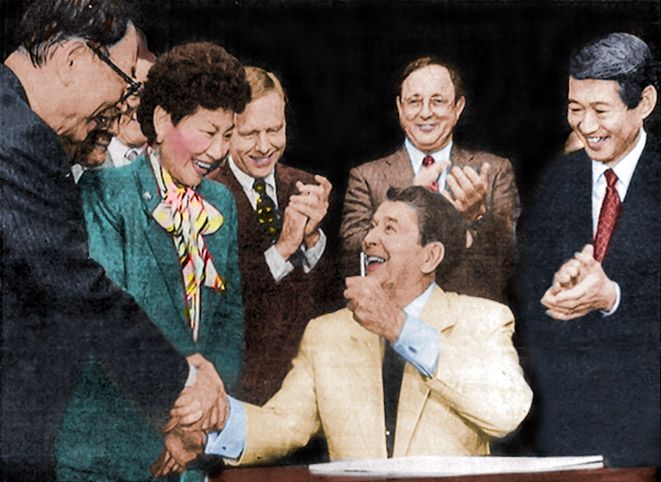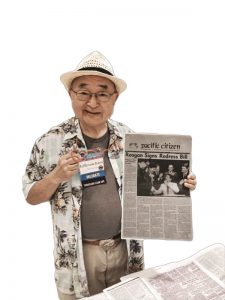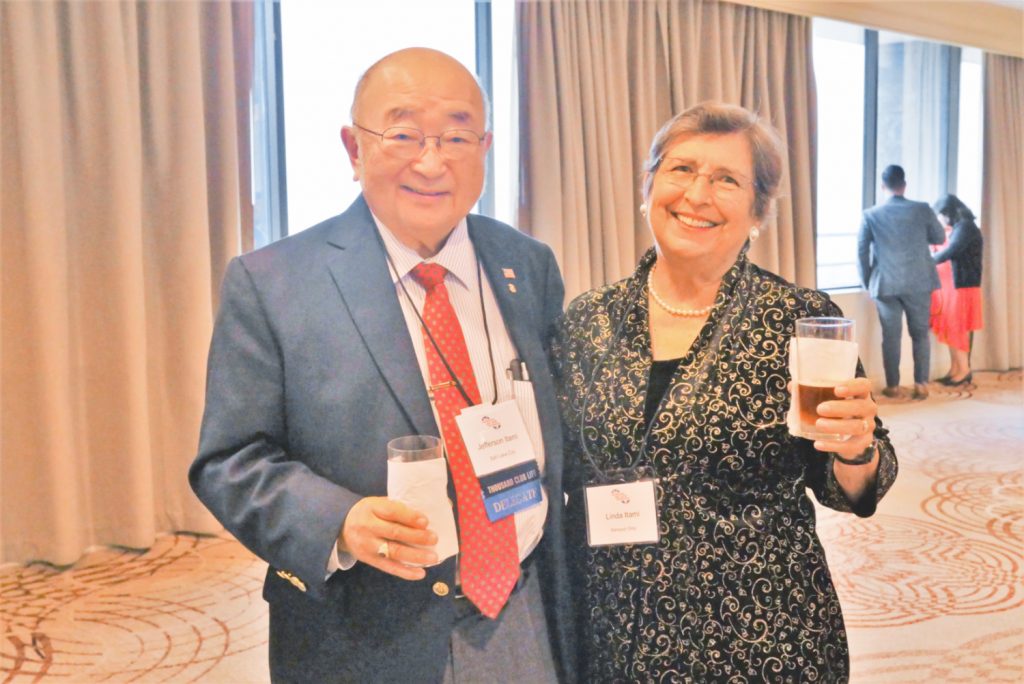
President Ronald Reagan (seated) signed the historic HR442 on Aug. 10, 1988. (Pacific Citizen file photo)
JACLer Jefferson Itami recalls his attendance at the White House by President Ronald Reagan for the historic signing of HR442 and S1009 into public law 383-100: The Redress Bill and Letter of Apology for the Wrongful Incarceration of Japanese Americans During World War II.
By Jefferson K. Itami, Former Incarceree Nr. 37009C
It began when I was invited to represent the Intermountain District Council of the JACL as one of two Redress Coordinators along with Mr. Hid Hasegawa, Idaho Falls chapter. I am with the Salt Lake Chapter of JACL.
My wife, Linda, and I drove to Seattle, Wash., to attend the August 1988 Biennial National Council of the JACL Convention on the campus of the University of Washington. We were housed in dormitories sharing four-person rooms with colleagues from IDC: Gov. Randy Harano and his wife shared the rooms with Linda and me.

Jefferson Itami with a historic P.C. issue at the 2019 JACL National Convention in Salt Lake City. He was in the audience when President Reagan signed HR442. (Photo: Allison Haramoto)
At the Opening Welcome Reception, the National JACL Legislative Education Committee had put up two display boards listing each of the proposed persons who were invited to attend the upcoming Redress Bill signing ceremony at either the Rose Garden (144 persons) or the White House Little Theater (75 persons).
The announcement came the next day while we were in a National Council session — President Reagan had decided to use the White House Little Theater in which to hold the Redress combined bill signing ceremony, and therefore, 75 listed persons were invited to this event.
Fortunately for me, I was on both lists, so, when the travel agency set up an office to secure round-trip tickets on a red-eye flight that evening to Washington, D.C., for the signing ceremony, I cleared it with Linda, then went to see our Salt Lake Chapter Coordinator, Ms. Alice Kasai, and asked her about going. She assured me that the chapter would support my travel, and so I got in line — thrilled with the anticipation of attending the historic (for our group) event.
I went to the Sayonara Banquet dressed in a golf shirt, windbreaker, Dockers and white leather sneakers. We 75 were like special operations troops preparing for a clandestine operation at a distant objective as we took seats. I rarely cannot recall a meal, but, I cannot recall what we had that evening. We were quietly called out and assembled outside at the curb to clamber into waiting busses that transported us to SeaTac Airport. My first trip to Washington, D.C.! What a memorable event in our lives!
Our flight had a layover in the middle of the night in Salt Lake City of all places! It was the same on our return flight, but, I got off of the plane and went into the corridor and used a pay phone to call my pal, Kevin Aoki. He finally answered the phone, and I happily announced I was en route to Washington, D.C., to a White House signing ceremony of the Redress Bill. He asked me, “Do you know what time it is?” I said, ‘Yep, it’s about 3 a.m.,’ and he hung up.
My coordinator from IDC, Mr. Hid Hasegawa, Idaho Falls Chapter of JACL, was also onboard. I didn’t actually see him until after we’d landed in Washington National Airport, changed in the public men’s restroom and had taken different shared taxi rides (groups of five) to the Sam Rayburn Building and was seated oddly enough at the same table of 10 with him that I saw good ole Hid! I still remember his cheery, happy countenance!
Congressman Norm Mineta hosted our chopped chicken salad luncheon in the Congressional Dining Room. He came to greet us and gave us words of encouragement, none of which I retained, but, a fellow witness asked him, “Mr. Congressman Mineta, do you know exactly how the signing ceremony will go?” He smiled and replied, “No, this is my first one as well.” That went over well!
After we’d finished lunch, one of the members of our group from another table informed us that there was a post office inside of the building, and we could get postcards and have them hand-stamped for that historic day as a memento like no other!
So, a number of us went downstairs, purchased postcards for those whose addresses we knew — like my parents, my home address and the like — and mailed them with the “hand-stamped” date and place! Oh, yeah, I don’t know where that particular “treasure” is now.
Then, we repeated the fleet of team taxis to the Old Executive Office building, which is across the street from the White House. We were guided into that building, where we entered into a “rite of passage” that included lining up, showing picture identification, being checked in on the preapproved list of 75 by officers of the National Capitol Police, then we were taken to elevators and went down four floors underground, where we were lead through tunnels “into the spaces under the White House” to the Little Theater, where the ceremony took place.
When you hear about “layers” of bureaucracy in the Federal Government, they are speaking literally, as the Sam Rayburn building went down underground 18 or more floors to a large armory and a 50-station shooting range, where I traded police shoulder patches with a lieutenant of the Capitol Police. The “Capitol Police Patches” I obtained will come into play a bit later on … just keep them in mind.
So, we were, technically speaking, “in” the White House theater, albeit four floors underneath it. I read an article in the Pacific Citizen by another attendee who remembered entering the Old Executive Office building and was confused by it, so they were under the impression we’d never been “in” the White House Little Theater, but they were incorrect. This may clarify their confusion as to whether or not we were “in” the White House.
The theater entryway came right off of the corridor, and the upper back was wide with two sets of stairs descending the steeply raked rows of seats trapped between them.
There was a small stage centered in front of the seats — it was the focal point of attention.
A small, dark wooden table was situated on the front left side of the stage facing us with a chair behind it. A single microphone stand with a white placard lay on the floor behind it. There were other white placards lying on the floor in various places, and when the sponsoring Congressional Representatives and Senators entered from stage left, they looked down at the placards and stood where they were located. Congressman Barney Frank examined the single placard behind the microphone and stepped forward without a word, picked it up and placed it in an inner jacket coat pocket. (Remember this fact!)
We sat pretty well jammed together in various rows facing the silent theater. I was sitting next to Hid Hasegawa on my right and another person I didn’t know on my left, about two-thirds of the way up. There were perhaps three or four rows behind us.
So, we had a clear view directly in front as the distance from seats to stage wasn’t very much or far.
A man stepped out and announced, “The President of the United States of America!” We stood up and applauded as President Reagan entered the stage, smiling, and he gave us his well-known hand wave. A large rush of domestic and international press corps suddenly filed down both sets of stairs and set up their cameras and microphones, and many still photographs were taken as the president entered onto the stage and stepped behind the podium microphone.
Remember, there were only 75 of us present. If the ceremony had been held in the Rose Garden, the list would’ve been 144. The press quickly arranged themselves behind us on the upper rail and were very quiet.
President Reagan, after we stopped clapping and sat down, drew a sheet of folded paper from inside his coat and began reading his short speech, recalling that during World War II, a young Army Captain had accompanied Gen. (Joseph) Stilwell to one of the incarceration camps for Americans of Japanese descent housed therein and read the short speech he’d read on behalf of the general at the presentation of a Japanese American Gold Star mother with a posthumous Silver Star medal and Purple Heart medals awarded to her son (Kazuo Masuda), who was buried in France at Biffontaine.
The president paused, then continued, explaining that he was that young Army Captain serving as an Adjutant to the General and recalled the words of President Franklin Delano Roosevelt that “all blood spilled in the service of our nation doesn’t recognize the color of the donor, but is blended with their brothers-in-arms and is of the same color, red.”
He stopped, folded and replaced his speech and announced that “he would now sign the long overdue apology and redress the wrongful incarceration and deprivation of our Constitutional Rights for those Americans of Japanese descent so incarcerated.”
Before he began signing the bills HR442 and S1009 into Public Law 383-100, he acknowledged the 100-year-old Gold Star mother of the Nisei soldier who’d perished during the war. He knelt at the edge of the stage and shook her hand and personally thanked her for the sacrifice of the life of her son. It was a very touching and emotional moment for all of us.
He took his place on the chair at the table as aides set a pile of copies of the bill before him, handing him one at a time, folding each copy to the correct page and discreetly indicating where he was to sign. Each time, President Reagan picked out an ink pen from the tray, which was laden with those special black pens, unscrewed the cap and after signing that copy of the bill, would turn and replace the cap and hand it to one of the congressional delegation behind him. Clerks would set aside each signed copy of the bill for later distribution to those members of Congress invited to the signing ceremony.
After he’d signed the last copy, President Reagan replaced the cap and placed that pen into an inner pocket of his coat and stood up as we applauded. He shook hands with the congressional delegation and turned, waved once more and walked off the stage.
In that moment, the jam-packed press swiftly and silently packed up their gear and left the auditorium as aides appeared and guided us out of the theater and into the corridor for our return walk to the Old Executive Office Building, from which we were instructed to once again take cabs up to the National Capitol Building, East Wing, for a reception with food and drink.
As we walked up to the Capitol building, out of curiosity, I stepped up to a nearby brass door and peered into the interior. I observed plain-clothes security officers through the glass doors. They were wearing blue blazers and grey slacks with black dress shoes and red neckties with a tiny pattern — the same as we were, the only difference was that they had Capitol Police round patches on the left front side.
I pulled out one of the new patches I had in my pocket and slapped it on my blazer. It had tiny plastic thread ends projecting on the back that caused the patch to securely adhere to my blazer.
I knocked on the glass, and the security officer looked out at me, saw the uniform patch, came and opened the door for me. I asked where the reception was being held, and he indicated a door midway down the hall just as a guide lead a group into the room. As we entered, I removed the patch, replaced it in my pocket, and we got plates, food and drinks to join Congressman Barney Frank, who pulled out the piece of paper he’d picked up on the stage.
He held it up and said, “I could see from the other pieces of paper with our names that that was where we were supposed to stand, but, gee, he’s the president, and they still put this behind the podium!” It had President Reagan’s name on it! We all clapped and cheered the humor of that moment.
There were a number of other comments from those congressional members who’d worked so hard to get the bills both in the House and the Senate passed. Many of us individually thanked them for their work. There was a lot of handshaking and smiles, after which we once again got into taxis for the ferrying back to Washington National Airport to retrieve our gym bags from the lockers there. We then flew right back to Sea Tac Airport, where busses took us to Seattle.
Once we’d arrived back, I rejoined Linda, who was staying with Uncle Hisashi and Aunt Margaret Mukumoto, my mom’s younger brother, who’d served in the 442nd in WWII and was wounded and decorated for his efforts; his father died in Heart Mountain Incarceration Camp, Wyoming.

Jefferson and Linda Itami (Photo: George Toshio Johnston)
One sidebar note: Poor Linda pulled her wrists and had to have an operation after we drove home, caused by lifting and dragging our heavy suitcases, which would’ve been my job if I’d have been there. Luckily, she was able to call Uncle Hash and Aunt Margaret and ask if she could stay with them until I returned a day later.
We had a very pleasant, fast drive from Seattle via the I-5 down to Portland, catching the turn off to I-80 Eastbound and back to Salt Lake City via Idaho.
Thus ends my tale of two cities: Seattle to Washington, D.C., on Aug. 10, 1988. A day to remember, yes, and thank you, Mr. President — the Honorable Ronald Reagan.



